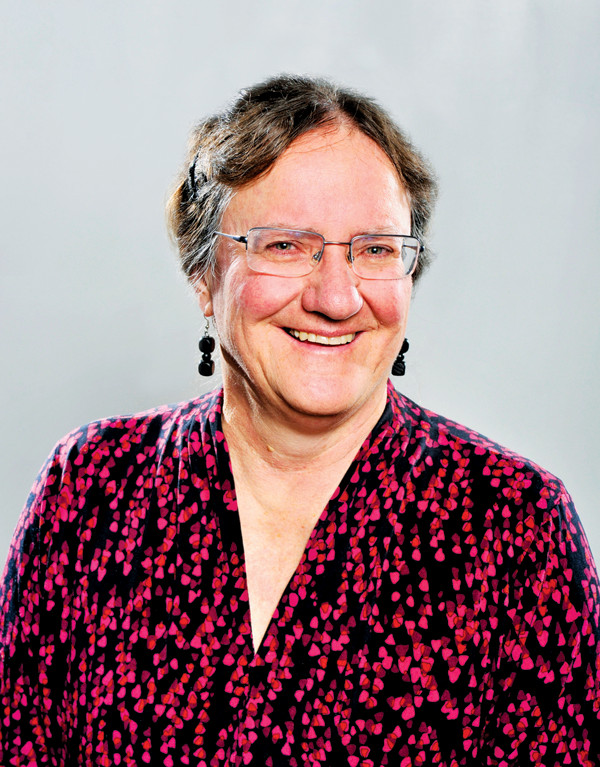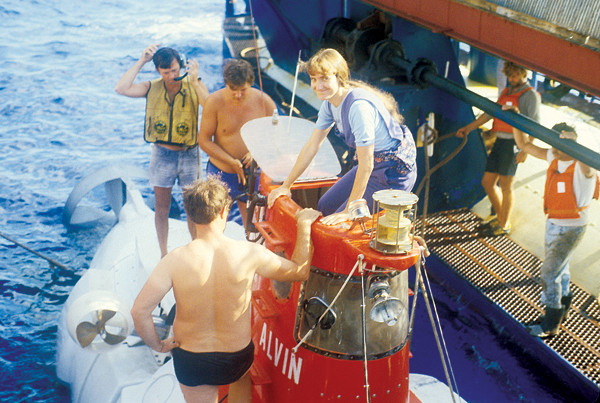
by Terri Cook Tuesday, December 16, 2014

Tanya Atwater is an emeritus professor at the University of California at Santa Barbara. Credit: Courtesy of Tanya Atwater.
When Tanya Atwater began graduate school in marine geology in 1967, it was considered unlucky for women to be aboard ships. Undaunted, Atwater signed up to work on the first research cruise to take a close look at a seafloor spreading center. Voyage after voyage, she and her mentors fought for her right to work on oceanographic vessels, and it is fortunate they did. Atwater has since had a remarkable career studying plate tectonics and was instrumental in piecing together the evolution of the San Andreas Fault plate boundary.
In 1980, Atwater joined the geology faculty at the University of California at Santa Barbara (UCSB), where she still serves as professor emeritus. In 1997, Atwater was elected to the National Academy of Sciences, and in 2002, she received a prestigious National Science Foundation (NSF) Director’s Award for Distinguished Teaching Scholars.
Atwater recently spoke with EARTH contributor Terri Cook about what launched her illustrious career, what it was like being on the cusp of the plate tectonics revolution, and why she used her NSF award to start the Educational Multimedia Visualization Center at UCSB (http://emvc.geol.ucsb.edu).
TC: I understand that the launch of Sputnik influenced your decision to become a scientist. How so?
TA: Sputnik was just a shiny, metal ball with a whisker sticking out of it, but that little thing changed a whole generation of careers. When I was a kid, there was all this science fiction: Guys were zooming off in spaceships and walking around on the moon and planets. We assumed it really was fiction, so when humans put Sputnik into orbit, that seemed astonishing, and it made me think that science could do anything. All the breakthroughs before that had been extrapolations — the early cars looked like buggies without a horse in front of them. But this was a huge leap of the imagination, a [demonstration] that physics and math were real and could make something work that we’d never had any experience with. Growing up I had thought I would become a commercial artist, but Sputnik caused me to switch to science.
TC: How did you become interested in geology?
TA: I shunned geology for quite a while because I thought it was such a grubby field. When I went to college I started in physics, and then I took an organic chemistry course, which was not something I could wrap my brain around. Next, I tried electrical engineering, but I almost electrocuted myself. Then I accidentally took a physical geology course, and I fell in love. There was no looking back. I somehow lucked into the perfect time and place for my particular abilities.
TC: How did having two scientist parents influence your worldview?
TA: My mother was a botanist who ran a botanical business, and my dad was an engineer who viewed every child as a bundle of potential. He felt it was the grown-ups’ job to let us know we could do anything. Scientists have a certain way of approaching the world; we believe that you should test things, base your opinions on observations, and try hard to keep yourself out of it. My artsy friends think that trying to minimize our humanness is really strange. [Science has] a different way of thinking about things, but since I grew up in it, I thought it was the natural way of viewing the world.
TC: How did your explorations of the West as a child leave their mark on you?
TA: My parents believed in the importance of being attached to wilderness and loving and understanding it. Back in the old days, before seat belts, they had this huge truck. They’d put my siblings and me and all of our friends in the back along with our camping gear, take us out to the desert, dump us on the sand, and let us be our wild selves.
I have taught introductory geology for a long time, and there’s always a subgroup in the class that have been backpacking and camping, and geology is completely obvious to them as soon as you explain it. Then there’s another group who have never seen a rock, never seen stars in the sky, and never slept on the ground. I put up my pictures of the scenery, and they have no idea what they’re looking at. It’s a huge plus just to have been outside. Kids are natural scientists; they’re always observing and figuring things out.
TC: What was your experience starting your career in the early days of the plate tectonics revolution?
TA: It was incredibly exciting; I couldn’t sleep at night. Throughout my undergraduate career, the big-picture stuff was very obscure and complicated. We had to learn a different and seemingly arbitrary history for each mountain belt. The moment I heard Jim Heirtzler’s talk about seafloor spreading, I knew everything had completely changed. It was like a bolt of lightning. Within a year, we figured out that all the complicated things geologists had been trying to explain were actually the different processes that happen at the edges of moving continents. Suddenly everything was simple!
TC: I understand that you once believed that you weren’t a good scientist if you admitted your passion. Why?
TA: The basic idea we learn as scientists is that to really be a good observer, you have to keep your emotions out of it. That’s the way science is taught to kids, and it’s completely boring and stupid. We don’t do science without passion. All the scientists I know love what they do!
So, I soon gave up trying to hide my passion, and my job as a teacher became showing students how fun and wonderful and interesting science is, and also to teach them the rules: Science must be based on observation, and you must be able to test your ideas. An interesting consequence is that science is always negative. You can never prove something; you can only disprove it. Science is so negative that I’ve almost quit it a couple of times because that aspect didn’t suit me very well. You have to remember that you’re trashing someone’s theory because the observations don’t add up, not because you’re into the competition.

Atwater was chief scientist on a 1978 Alvin submersible expedition to study spreading processes on the Mid-Atlantic Ridge. Credit: Courtesy of Tanya Atwater.
TC: What was it like to be an exchange scientist in the Soviet Union during the Cold War?
TA: The entire Soviet system was built on paranoia, and although they were nervous about us, they were mostly nervous about their own people. From time to time, Russians had to spy on their neighbors. They couldn’t say no, because they’d look suspicious, but if they said yes, they had to figure out what to report that sounded like they were doing their job but wouldn’t get anyone in trouble.
Someone early on had decided that all maps were classified. Geologists therefore had to have high clearances, and the geologic maps hanging on their office walls all had to have curtains hanging in front of them. To show me their maps — which they weren’t supposed to do — they had to close the door, pull the blinds, and then slide back the curtain. … It made me value our country that much more.
TC: You were on the Alvin expedition that first visited the seafloor hydrothermal vents and discovered their bizarre chemosynthetic fauna, like giant tubeworms and clams at the Galapagos spreading center in 1977. What were you searching for on those dives?
TA: It was a geochemical trip. I was along on those dives because I was going to lead a later expedition and needed to gain some experience. When the geochemists of old were trying to figure out the chemical balance in the oceans, they took all the known inputs and outputs and added them up, but it was really clear that something was missing. They were hoping to get samples of the vent waters to learn what was in them. Before this discovery, scientists towing a thermistor [a temperature gauge] had measured some tiny temperature blips near the seafloor, and they had taken pictures that included a bunch of dead clamshells strewn across the seafloor. They had speculated, half seriously, that people on a ship had a clambake and had thrown all the shells overboard, but that was a suspicious explanation. With hot lava so near the surface and cold water right above it, everyone suspected there must be circulation, but nobody expected it to be so fantastic. We dove down and began seeing all these weird animals, including a foot-long clam with bright red meat. That was pretty wild!
TC: How do you see the acceptance of women in science having changed during your career?
TA: In graduate school, people sometimes assumed I was somebody’s girlfriend who was tagging along. I tried to interpose a sentence or two with the right language to establish who I was, but not everyone got it. I wasn’t insulted; we all have assumptions, and the assumption about women at that time was that we weren’t scientists. It’s astonishing to see how much things have changed now.
TC: Why did you use the funds from your teaching scholar award to start a multimedia visualization center?
TA: As a child on family trips, I always hogged the maps, acting as navigator and taking great pleasure in translating between the two-dimensional lines on the paper and the passing landscape. I love spatial relationships, and I’m trying to create the right visual tools to help people realize that the Earth is beautiful and interesting and worth paying attention to. The first movies we made used plastic celluloids like Disney used to do — 24 cels per second — which was a lot of work. Then, in the 1990s, I tried computer animation. As soon as I started putting out visualizations, especially of the San Andreas plate boundary with its various plates moving in various directions, I was amazed. People suddenly got it! Humans just have a different intuition with moving things. By the time I got that award, I wanted to create as many animations as I could to help people understand geological processes.
TC: Do you believe that scientific literacy is an important issue for our nation today?
TA: It’s absolutely crucial. Many people are turned off by science because of the way it’s taught and because they think it’s just too difficult, or that it just consists of memorizing a bunch of boring facts. But science is crucially important because we all live in a scientific, technology-driven world. For a person to be comfortable living in it, and to vote, they need to have scientific literacy.
© 2008-2021. All rights reserved. Any copying, redistribution or retransmission of any of the contents of this service without the expressed written permission of the American Geosciences Institute is expressly prohibited. Click here for all copyright requests.